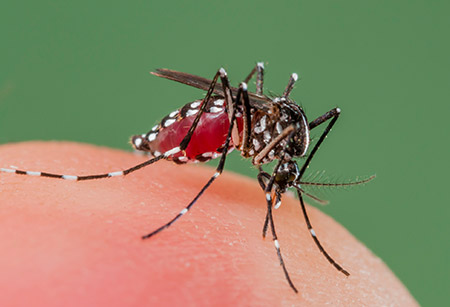The chikungunya virus is spread to humans by the bite of infected mosquitoes, which become infected by feeding on people who already have the virus.
Researchers have found that the virus responsible for chikungunya fever can spread directly from cell to cell, an advance that could help in developing effective vaccines or treatments for the debilitating and increasingly common mosquito-borne disease.
Read More: Health Hacks: 5 surprising advantages of eating Raw Turmeric
The findings, published in the journal Nature Microbiology, likely solve the longstanding mystery of how the virus, now emerging as a major health threat, can manage to escape antibodies circulating in the bloodstream.
“Previously, chikungunya virus was thought to spread in the body by infecting a cell, replicating within that cell, and then sending new copies of the virus into the bloodstream that then infect new cells,” said study leader Margaret Kielian, a professor at Albert Einstein College of Medicine, US.
“However, we’ve found that the virus can also hijack a host cell’s cytoskeleton—the proteins that support cells and maintain their shape. The virus causes the infected cell to send out long thin extensions that make contact with uninfected neighbouring cells, enabling the virus to safely and efficiently travel from one cell to another,” Kielian said.
Read More: High Blood Pressure To Pancreatic Cancer, Three Health Issues That Are Silent Killers
“This mode of viral transmission may not only shield some copies of the virus from the host’s immune response, but it may also explain why symptoms of chikungunya infection can persist for many months or years,” added first author Peiqi Yin, a postdoctoral fellow in Kielian’s lab.
In addition to fever, infections from chikungunya often lead to chronic and debilitating arthritis.
Over the past 15 years, the chikungunya virus has become an important and increasingly widespread human pathogen. Multiple outbreaks have caused millions of human infections in numerous areas including the Americas, Africa, Asia, Europe, and the Caribbean.
The first part of the study involved the use of cultured mouse cells. The researchers exposed the cells to the chikungunya virus that expressed a fluorescent reporter protein, allowing them to observe that infectious virus particles were indeed being transmitted from cell to cell via ILEs.
Cell-to-cell transmission occurred even in the presence of high quantities of neutralising antibodies that were added to the culture medium, they said.
Read More: Does Chocolate Craving Indicates Magnesium Deficiency? Find Out
To confirm this mode of cell-to-cell transmission in living animals, the researchers studied chikungunya infection in mice. Mice that were first inoculated with neutralising antibodies and were then directly injected with the chikungunya virus did not become infected.
However, antibody-treated mice that were then injected with virus-infected cells, rather than just the virus, did develop chikungunya infections that were resistant to the neutralising antibodies.
”Together, these studies show that ILEs shield the chikungunya virus from neutralising antibodies and promote intercellular virus transmission, both in vitro and in vivo,” said Yin.
In a final set of studies, the researchers determined that certain antiviral antibodies were able to block ILEs from forming and prevent cell-to-cell transmission.
“If we can generate the production of such antibodies in human patients, or develop other methods to stop ILE formation, that could be especially helpful in combatting the chronic symptoms of chikungunya infection,” Kielian added.





































